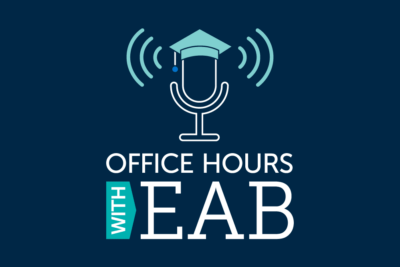5 reasons graduate student list-buying is so hard
Before joining EAB, I spent more than 6 years in recruitment marketing for a large public institution. In this role, I often worked with graduate prospect lists (like GMAT and GRE), so I know firsthand the frustrations they can cause. Clunky, slow list procurement. Lists that are outdated by the time they arrive. Time-intensive processing. Imprecise targeting. And the toughest challenge of all: tracking ROI. These issues eat up valuable time for marketing and data teams, often costing enrollments as a result.
To further explore these challenges and how to overcome them, I partnered with Patrick Farabaugh, one of EAB’s list-buying experts in our Adult Learner Recruitment division. Read on to uncover five hidden list-buying challenges for enrollment marketers, how much they could be costing your team, and how to solve them.
Learn about Appily Advance, EAB’s graduate and adult-serving program lead-gen solution
1. List procurement pitfalls
According to Patrick, one of the initial challenges in purchasing leads, whether from test-taker lists, lead aggregators, or other sources, is navigating the operational differences between list sources. Each source requires distinct steps for ordering, selecting criteria, processing billing, and formatting files. Additionally, list sources often make annual system changes, so even purchasing the same list can involve learning a new process each year.
On the campus side, if you don’t control your budget, you may need approval from multiple people or offices each time you purchase a list. This bottleneck can create recruitment delays, particularly when buying multiple lists throughout the year.
- ESTIMATED TIME LOST: 3-6 hours
2. Operational challenges of list processing
Once you have lists in hand, several tedious, time-intensive steps must happen before you can actually use the leads. Lists need to be manually formatted and uploaded into your CRM, de-duped for repeat contacts, and tagged to the right marketing campaigns. If you’re purchasing multiple lists at the same time, the workload can double or triple for marketing and data teams—posing a challenge for schools with small or overburdened data teams that struggle to track and monitor each lead source effectively.
Beyond processing, timing matters. Some lists see higher volumes at different points in the year, so Patrick emphasized that schools need to consider not just what lists to buy, but when to buy them. If this step isn’t managed efficiently, outreach won’t be timely, resulting in missed enrollment opportunities.
- ESTIMATED TIME LOST: 10-20 hours per list
3. Change in test-taker and search behavior
If test-taker lists are your primary lead source, you’ve likely noticed a decline in effectiveness. For example, the shift toward test-optional admissions led to a 45% decline in GRE test-takers between 2019 and 2024, shrinking both the volume and quality of available leads. Test-taker lists are also static, arrive infrequently, and are often outdated by the time they reach institutions—hindering timely outreach. While our data shows these lists still play an important role in lead generation, their overall impact is not as strong as it once was.
At the same time, student search behavior has fundamentally changed. As many as 80% of today’s prospective students are stealth shopping, meaning they are researching colleges anonymously and delaying direct engagement until they’re ready to apply. Schools that haven’t diversified their lead-generation strategies to include organic tactics such as search engine optimization (SEO), enrollment-centered web content strategy, and inbound marketing risk missing out on these prospective students.
- TIME LOST: Weeks or months over a cycle due to wasted recruitment efforts
4. Lack of precision in targeting
Patrick detailed another critical challenge: determining which list sources best fit each program can be a time-intensive hurdle when it comes to precise targeting. Without a well-defined student profile, schools risk wasting time and resources recruiting wrong-fit contacts. For example, I still receive targeted ads and paid LinkedIn messages inviting me to earn my master’s in social work—a degree I earned in 2015. Outdated, overly broad targeting wastes valuable marketing dollars without delivering results.
This issue is further compounded by the fact that many institutions rely on the same lists and tactics, creating intense competition for the same prospects. By the time your marketing messages reach candidates, they’re more likely to feel like white noise.
- TIME LOST: 5-15 hours per campaign
5. Proving ROI
Traditional lead generation methods often prioritize quantity over quality and require a fair amount of guesswork, making it difficult to justify costs. The long tail from initial outreach to enrollment further complicates ROI measurement, as value may not be immediately clear.
While calculating ROI for a single list may seem simple, it’s often less straightforward than you think. Many schools struggle to connect leads to actual enrollments because tracking can be imprecise—especially as student records move from one system to another, such as a CRM to a student information system (SIS) after acceptance. Once a student transitions out of the CRM, enrollment teams may lose visibility into whether they enroll, requiring manual data reconciliation to bridge the gap.
- TIME LOST: Potentially months in enrollment cycle
TOTAL TIME LOST: 20–50+ hours per list
While this is, of course, just an estimate, it highlights the inefficiencies of the list buying and management process—ultimately resulting in time lost for recruitment and lead nurturing. And when you factor in lost conversions and the impact on yield, the costs grow significantly.
Learn how one partner lowered average cost per lead while increasing responder volume by 126%
What can graduate marketing teams do to avoid these hidden, hard-to-quantify hurdles?
We’ve identified inefficiencies in the list buying process—but that doesn’t mean you should abandon it altogether. Instead, a smarter approach is to diversify your lead-generation strategy to improve efficiency and reach high-intent students. To stay competitive, schools should:
- Expand lead sources to build a robust, targeted candidate pool.
- Identify ideal student profiles and align organic strategies with student search behavior.
- Use strategic filters to focus on high-intent candidates throughout their decision journeys.
- Optimize lead acquisition by partnering with providers that refine criteria and deliver high-intent leads at scale.
- Leverage inbound strategies such as SEO, web optimization, and content marketing to improve efficiency and ROI.
-
25%
faster response from Appily Advance leads vs. schools’ test-taker lists
Implementing these strategies takes time but working with a lead acquisition provider can help you scale faster. Solutions such as Appily Advance complement full-funnel marketing and lead-generation strategies by streamlining the process and freeing up your time for high-impact recruitment. Our lead-generation experts analyze hundreds of schools and hundreds of thousands of student profiles, giving them unique insight into the characteristics that best match your institution. We then deliver high-intent leads from a variety of constantly refreshing sources—including digital ads, national consumer data, a network of affiliate partners, and proprietary sources containing data from more than 17 million active student users.
By addressing inefficiencies and refining your approach, you can focus on high-intent prospects—those most likely to convert—ensuring that marketing efforts are more precise, cost-effective, and impactful in driving enrollment.

Why Recruiting Adult Learners is a Year-Round Mission

Engaging the Modern Graduate Business Student

More Blogs

What changed in the graduate lead gen landscape in 2025

We secret shopped 40 graduate programs’ lead nurturing campaigns. Here’s what we learned.

The higher ed SEO checklist
Great to see you today! What can I do for you?